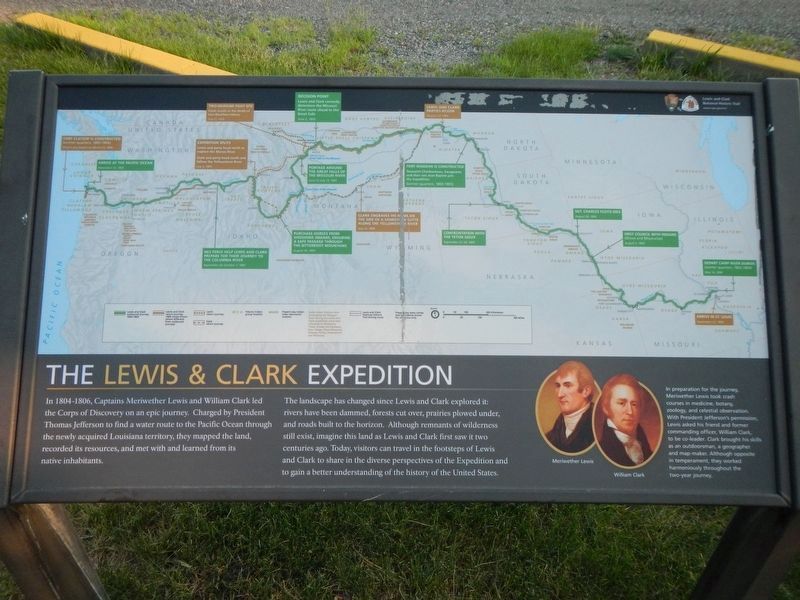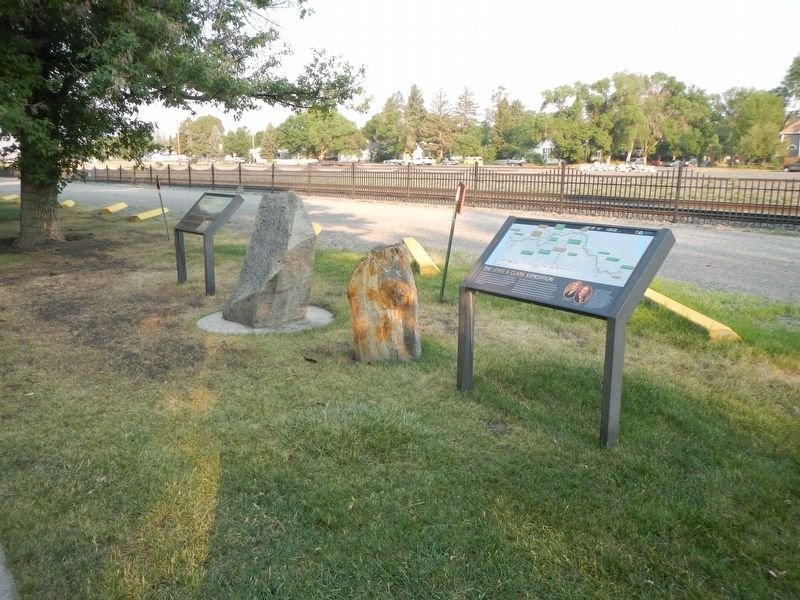Livingston in Park County, Montana — The American West (Mountains)
The Lewis & Clark Expedition

Photographed By Barry Swackhamer, July 24, 2021
1. The Lewis & Clark Expedition Marker
NOTABLE OUTBOUND POINTS (green, east to west): Depart Camp River Dubois, (winter quarters, 1803-1804) May 14, 1804; First Council with Indians (Otoes and Missourias) August 3, 1804; Sgt. Charles Floyd Dies, August 10, 1804; Confrontation with the Teton Sioux, September 25-28, 1804; Fort Mandan is Constructed, Toussaint Charbonneau, Sacagawea and their son Jean Bapiste join the Expedition. (winter quarters, 1804-1805; Decision Point, Lewis and Clark correctly determine the Missouri River route ahead to the Great Falls, June 2, 1805; Portage Around the Great Falls of the Missouri River, June 13 - July 15, 1805; Purchase Horses from Shoshone Indians, ensuring a Safe Passage through the Bitterroot Mountains, August 30, 1805; Nez Perce help Lewis and Clark prepare for their Journey to the Columbia River, September 26 - October 7, 1805; Arrive at the Pacific Ocean, November 15, 1805.
NOTABLE INBOUND POINTS (orange, west to east): Fort Clatsop is Constructed, (winter quarters, 1805-1806), Return trip begins on March 23, 1806; Expedition Splits, Lewis and party head north to explore the Marias River. Clark and party head south and follow the Yellowstone River., July 3, 1806, Clark Engraves his name on the side of a Sandstone Butte along the Yellowstone River, July 25, 1806; Lewis and Clark Parties Rejoin, August 17, 1806; Arrive in St. Louis, September 23, 1806.
NOTABLE INBOUND POINTS (orange, west to east): Fort Clatsop is Constructed, (winter quarters, 1805-1806), Return trip begins on March 23, 1806; Expedition Splits, Lewis and party head north to explore the Marias River. Clark and party head south and follow the Yellowstone River., July 3, 1806, Clark Engraves his name on the side of a Sandstone Butte along the Yellowstone River, July 25, 1806; Lewis and Clark Parties Rejoin, August 17, 1806; Arrive in St. Louis, September 23, 1806.
The landscape has changed since Lewis and Clark explored it; rivers have been dammed, forests cut over, prairies plowed under, and roads built to the horizon. Although remnants of wilderness still exist, imagine this land as Lewis and Clark first saw it two centuries ago. Today, visitors can travel in the footsteps of Lewis and Clark to share in the diverse perspectives of the Expedition and to gain a better understanding of the history of the United States.
In preparation for the journey, Meriwether Lewis took crash courses in medicine, botany, zoology, and celestial observation. With President Jefferson's permission Lewis asked his friend and former commanding officer, William Clark to be co-leader. Clark brought his skills as an outdoorsman, a geographer and map-maker. Although opposite in temperament, they worked harmoniously throughout the two-year journey.
Erected by Lewis and Clark National Historic Trail, National Park Service.
Topics and series. This historical marker is listed in this topic list: Exploration. In addition, it is included in the Lewis & Clark Expedition series list.
Location. 45° 39.665′ N, 110° 33.851′ W. Marker is in Livingston, Montana, in Park County. Marker is on West Park Street near North Yellowstone Street, on the left when traveling west. The marker is located in Northern Pacific Depot Park. Touch for map. Marker is at or near this postal address: 323 West Park Street, Livingston MT 59047, United States of America. Touch for directions.
Other nearby markers. At least 8 other markers are within walking distance of this marker. "...high rugid mountain..." (here, next to this marker); First Lewis and Clark Trail Marker (a few steps from this marker); Livingston Westside Residential Historic District (within shouting distance of this marker); Murray Hotel (about 500 feet away, measured in a direct line); 315 West Callender (about 600 feet away); First National Bank / Masonic Temple (about 600 feet away); Hugh J. Miller Home (about 600 feet away); Pape Building (about 700 feet away). Touch for a list and map of all markers in Livingston.
Credits. This page was last revised on January 28, 2022. It was originally submitted on January 28, 2022, by Barry Swackhamer of Brentwood, California. This page has been viewed 122 times since then and 8 times this year. Photos: 1, 2. submitted on January 28, 2022, by Barry Swackhamer of Brentwood, California.
